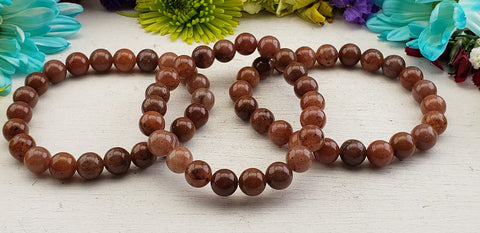Red Aventurine Properties & Use
Red aventurine is a cherry red stone that is, of course, a variety of aventurine. Green is the most common color for aventurine, and despite some misconception, other natural colors do exist.
The main source of confusion almost certainly lies in the fact that goldstone is also called aventurine glass. The name got adapted for aventurine, the natural mineral, because it refers to the metallic shimmer effect present in both stones. Aventuresence is the name attributed to this effect. Aventurine is still sometimes used, though rarely, to refer to the glass.
Real aventurine is quartz that happens to have this affect from inclusions of mica and hematite, for example. These days, most people use aventurine to refer to the actual mineral that we are writing about. Goldstone, then, is reserved for the glass that is believed to be discovered by accident, though this is not confirmed as completely true by historians.

At any rate, does aventurine have any practical use? Not really. It has a respectable 6.5–7 on the Mohs scale, which makes it a fairly common choice for jewelry at the least. Sometimes you'll find unique carvings and pendants made from the stone. But, other times, you'll find tumbled stones as well.
Red aventurine ranges from a pale beige-orange to a deeper red-orange, and may even extend into the maroon family. As a result, "orange aventurine" can refer to certain shades of red aventurine, as the color is merely a descriptor. It is a mostly opaque stone with slight internal sparkle, and may exhibit banding or spots of other stones growing within or alongside it.
Metaphysical Properties of Red Aventurine
Crystal healing and metaphysical communities claim stones possess therapeutic or spiritual properties, but it is important to note that these claims have no scientific basis. These claims are also not endorsed by healthcare professionals. It is not recommended substitute crystals for professional care or treatment. There is no scientific evidence supporting the idea that specific crystals have any real benefits aside from the placebo effect. While meditation can have some benefits, it should not be viewed as a replacement for scientifically validated conventional medical practices.
It is advisable to consult medical professionals for any health concerns, and the use of crystals or meditation should not be seen as a substitute for seeking professional medical or health advice, treatment, or expertise. In the absence of scientific evidence, it is essential to prioritize evidence-based medical practices. Regardless, crystal healers believe that green aventurine has metaphysical properties, such as:
"Red Aventurine resonates with the Fire and Earth Elements, bringing both security and passion to the fore. If you want to get in touch with your life force (prana) this stone awakens you from the core of your being. Red aventurine stimulates your self-awareness allowing for you to see a true picture of yourself and find introspection. Red Aventurine is associated with the Root, Sacral, and Solar Plexus Chakras. It brings a greater understanding of reality, earthly needs and desires, and our ability to influence the world around us with our behaviors, choices, and willpower. In this way, Red Aventurine helps us to overcome fears and doubts, providing the stability we need to focus on success, growth, and action."
The Wrap Up
Red aventurine is a stone with a splash of wine red that makes it stand out when compared to other shades of aventurine. Its dark and moody appearance can make it suited for certain types of men's jewelry (if you happen to find it). Red aventurine is a pretty crystal without much practical use, so don't be shy about checking out all the cool stuff people do with it!

